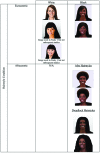Hair penalties: the negative influence of Afrocentric hair on ratings of Black women's dominance and professionalism
- PMID: 26379612
- PMCID: PMC4553896
- DOI: 10.3389/fpsyg.2015.01311
Hair penalties: the negative influence of Afrocentric hair on ratings of Black women's dominance and professionalism
Abstract
Purpose: Women are penalized if they do not behave in a stereotype-congruent manner (Heilman, 1983, 2001; Eagly and Carli, 2007). For example, because women are not expected to be agentic they incur an "agency penalty" for expressing anger, dominance or assertiveness (Rudman, 1998; Rudman and Glick, 1999, 2001; Eagly and Karau, 2002; Rudman and Fairchild, 2004; Brescoll and Uhlmann, 2008; Livingston et al., 2012). Yet, all women are not equally penalized (Livingston et al., 2012). We make a novel contribution by examining how both White and Black evaluators respond to displays of Black women's dominance, in this case, whether Black women choose to wear Afrocentric or Eurocentric hairstyles.
Design/methodology/approach: We conducted three experimental studies to examine the influence of target hairstyle and participant race on ratings of the target's professionalism (Studies 1, 2, and 3) and dominance (Study 2). Study 1 was an online experimental study with 200 participants (112 females, 87 males, 1 missing gender; 160 Whites, 19 Blacks, 11 Latinos, 7 Asian Americans and 3 who identify as "other"; M age = 35.5, SD = 11.4). Study 2 was an online experimental study with 510 participants (276 women, 234 males; 256 Blacks, 254 Whites; M age = 41.25 years, SD = 12.21). Study 3 was an online experimental study with 291 participants (141 Blacks, 150 Whites, M age = 47.5 years, SD = 11.66).
Findings: Black, as compared to White, evaluators gave higher agency penalties to Black employment candidates when they donned Afrocentric versus Eurocentric hair, rating them as more dominant and less professional.
Implications: The present research illustrates the significance of considering both target and evaluator race when examining the influence of agency, and specifically dominance, on ratings of professionalism.
Keywords: Black; agency; diversity; dominance; hair; professionalism; race; women.
Figures




Similar articles
-
Natural Hair: a Vital Component to Black Women's Health.J Racial Ethn Health Disparities. 2021 Dec;8(6):1573-1582. doi: 10.1007/s40615-020-00922-4. Epub 2020 Nov 17. J Racial Ethn Health Disparities. 2021. PMID: 33201404
-
Angry White Faces: A Contradiction of Racial Stereotypes and Emotion-Resembling Appearance.Affect Sci. 2022 Mar 1;3(1):46-61. doi: 10.1007/s42761-021-00091-5. eCollection 2022 Mar. Affect Sci. 2022. PMID: 36046095 Free PMC article.
-
Bargaining while Black: The role of race in salary negotiations.J Appl Psychol. 2019 Apr;104(4):581-592. doi: 10.1037/apl0000363. Epub 2018 Oct 18. J Appl Psychol. 2019. PMID: 30335407
-
Can an agentic Black woman get ahead? The impact of race and interpersonal dominance on perceptions of female leaders.Psychol Sci. 2012 Apr;23(4):354-8. doi: 10.1177/0956797611428079. Epub 2012 Mar 14. Psychol Sci. 2012. PMID: 22421203
-
The subtle suspension of backlash: A meta-analysis of penalties for women's implicit and explicit dominance behavior.Psychol Bull. 2016 Feb;142(2):165-97. doi: 10.1037/bul0000039. Epub 2015 Dec 21. Psychol Bull. 2016. PMID: 26689089 Review.
Cited by
-
The Value of Integrating Evolutionary and Sociocultural Perspectives on Body Image.Arch Sex Behav. 2022 Jan;51(1):57-66. doi: 10.1007/s10508-021-01947-4. Epub 2021 Mar 9. Arch Sex Behav. 2022. PMID: 33751287 No abstract available.
-
The strong Black woman stereotype and identity shifting among Black women in academic and other professional spaces.Womens Health (Lond). 2025 Jan-Dec;21:17455057251335358. doi: 10.1177/17455057251335358. Epub 2025 Jun 7. Womens Health (Lond). 2025. PMID: 40482016 Free PMC article.
-
Body dissatisfaction widens the racial disparities of Benzophenone-3, a chemical biomarker of personal care and consumer product usage.medRxiv [Preprint]. 2024 Aug 26:2024.08.26.24312258. doi: 10.1101/2024.08.26.24312258. medRxiv. 2024. Update in: Environ Int. 2025 Aug;202:109557. doi: 10.1016/j.envint.2025.109557. PMID: 39252908 Free PMC article. Updated. Preprint.
-
The weaponization of professionalism against physicians of color.Hum Resour Health. 2024 Jul 16;22(1):52. doi: 10.1186/s12960-024-00931-y. Hum Resour Health. 2024. PMID: 39014457 Free PMC article.
-
Dress is a Fundamental Component of Person Perception.Pers Soc Psychol Rev. 2023 Nov;27(4):414-433. doi: 10.1177/10888683231157961. Epub 2023 Mar 23. Pers Soc Psychol Rev. 2023. PMID: 36951208 Free PMC article. Review.
References
-
- Ashforth B., Mael F. (1989). Social identity theory and the organization. Acad. Manage. Rev. 14 20–39. 10.2307/258189 - DOI
-
- Bell E., Nkomo S. (2003). Our Separate Ways: Black and White Women and the Struggle for Professional Identity. Boston, MA: Harvard Business School Press.
-
- Bellinger W. (2007). Why African American women try to obtain “good hair”. Sociol. Viewp. 23 63–72.
-
- Boldry J., Gaertner L., Quinn J. (2007). Measuring the measures: a meta-analytic investigation of the measures of out-group homogeneity. Group Process. Intergr. Relat. 10 157–178. 10.1177/1368430207075153 - DOI
LinkOut - more resources
Full Text Sources
Other Literature Sources

